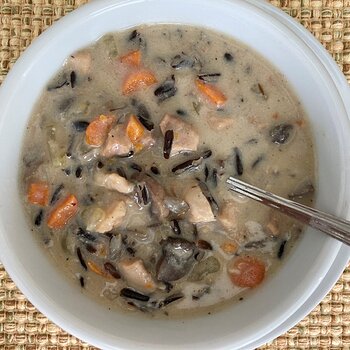new potatoes
The potato is a starchy tuber of the plant Solanum tuberosum and is a root vegetable native to the Americas, with the plant itself being a perennial in the nightshade family Solanaceae.Wild potato species, originating in modern-day Peru, can be found throughout the Americas, from Canada to southern Chile. The potato was originally believed to have been domesticated by Native Americans independently in multiple locations, but later genetic testing of the wide variety of cultivars and wild species traced a single origin for potatoes, in the area of present-day southern Peru and extreme northwestern Bolivia. Potatoes were domesticated approximately 7,000–10,000 years ago there, from a species in the Solanum brevicaule complex. In the Andes region of South America, where the species is indigenous, some close relatives of the potato are cultivated.
Potatoes were introduced to Europe from the Americas in the second half of the 16th century by the Spanish. Today they are a staple food in many parts of the world and an integral part of much of the world's food supply. As of 2014, potatoes were the world's fourth-largest food crop after maize (corn), wheat, and rice. Following millennia of selective breeding, there are now over 5,000 different types of potatoes. Over 99% of presently cultivated potatoes worldwide descended from varieties that originated in the lowlands of south-central Chile. The importance of the potato as a food source and culinary ingredient varies by region and is still changing. It remains an essential crop in Europe, especially Northern and Eastern Europe, where per capita production is still the highest in the world, while the most rapid expansion in production over the past few decades has occurred in southern and eastern Asia, with China and India leading the world in overall production as of 2018.
Like the tomato, the potato is a nightshade in the genus Solanum, and the vegetative and fruiting parts of the potato contain the toxin solanine which is dangerous for human consumption. Normal potato tubers that have been grown and stored properly produce glycoalkaloids in amounts small enough to be negligible to human health, but if green sections of the plant (namely sprouts and skins) are exposed to light, the tuber can accumulate a high enough concentration of glycoalkaloids to affect human health.
View More On Wikipedia.org
Potatoes were introduced to Europe from the Americas in the second half of the 16th century by the Spanish. Today they are a staple food in many parts of the world and an integral part of much of the world's food supply. As of 2014, potatoes were the world's fourth-largest food crop after maize (corn), wheat, and rice. Following millennia of selective breeding, there are now over 5,000 different types of potatoes. Over 99% of presently cultivated potatoes worldwide descended from varieties that originated in the lowlands of south-central Chile. The importance of the potato as a food source and culinary ingredient varies by region and is still changing. It remains an essential crop in Europe, especially Northern and Eastern Europe, where per capita production is still the highest in the world, while the most rapid expansion in production over the past few decades has occurred in southern and eastern Asia, with China and India leading the world in overall production as of 2018.
Like the tomato, the potato is a nightshade in the genus Solanum, and the vegetative and fruiting parts of the potato contain the toxin solanine which is dangerous for human consumption. Normal potato tubers that have been grown and stored properly produce glycoalkaloids in amounts small enough to be negligible to human health, but if green sections of the plant (namely sprouts and skins) are exposed to light, the tuber can accumulate a high enough concentration of glycoalkaloids to affect human health.
View More On Wikipedia.org
-

Chicken & Wild Rice Soup with Mushrooms
I made this in the Instant Pot aka Pressure Cooker. I didn't care the texture of the Mushrooms and made it again using New Potatoes instead.- kaneohegirlinaz
- Media item
- chicken cremini/crimini/swiss brown/chestnut mushrooms new potatoes wild rice
- Comments: 0
- Album: I Love Soup!
- Category: Soups, Stews and Casseroles
-

Recipe Quick red wine chicken stew
I made this several nights ago. The flavors melded very nicely. Recipe can easily be doubled. 3 servings 1/4 cup AP flour 1 tsp dried thyme, divided 1 tsp salt, divided 3 boneless skinless thighs 1 Tbsp olive oil 2 pieces bacon, sliced into 1/4 inch pieces 1 Tbsp tomato paste 1 cup chicken...- medtran49
- Thread
- carrot casserole chicken cremini/crimini/swiss brown/chestnut mushrooms new potatoes quick red wine
- Replies: 0
- Forum: Meat, Poultry & Game
-

Recipe Seared Scallops & Pea Purée - a perfect appetizer
Hello, hello! I'm a recent addition to this community, and I wanted to share a recipe I made for an elegant, healthy and fabulously tasty appetizer. It involves large succulent scallops, an aromatic pea purée, asparagus spears and baby potatoes. Ingredients 12 Large scallops 12 Asparagus...- Cinnamonita
- Thread
- appetizer/starter/hors d'oeuvre asparagus edible flowers green/garden peas new potatoes plating up scallops tarragon
- Replies: 12
- Forum: Fish & Seafood
